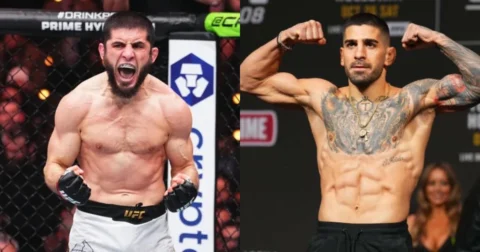In a breathtaking display of dominance, Khamzat Chimaev claimed the UFC middleweight title by dethroning Dricus du Plessis at UFC 319 on 16th August 2025, with a resounding unanimous decision victory of 50-44. This victory not only signifies a shift in the middleweight division from its traditionally striker-dominated history to a new era led by grappling prowess, as highlighted by former champion Michael Bisping, but it also raises crucial questions about how future contenders will adapt to Chimaev’s relentless wrestling style, marking a pivotal moment for the sport.
Chimaev’s Dominant Performance at UFC 319
Khamzat Chimaev made headlines on 16th August 2025, when he claimed the UFC middleweight championship by defeating Dricus du Plessis at UFC 319, held before a packed audience of 20,023 fans at Chicago’s United Center. The victory, a decisive unanimous decision with all judges scoring it 50-44, showcased not only Chimaev’s effectiveness but also his wrestling-heavy game plan, a striking contrast to the striking-heavy approaches typically associated with champions in the middleweight division. This win marked a significant turning point in how title fights at 185 pounds might unfold in the future, indicating a potential shift towards wrestling-dominant fighters.
Chimaev’s methodical dismantling of du Plessis underscored his grappling prowess, limiting the South African fighter’s ability to execute his unorthodox striking techniques, which had served him well in previous bouts. This strategic victory highlights a growing trend in the UFC where wrestling is becoming an essential component of a champion’s toolkit, reflecting a possible new era in the middleweight division. The fight effectively ended du Plessis’ three-fight defence streak, which included significant wins against established strikers, showcasing Chimaev’s ability to neutralise such threats effectively.
Michael Bisping’s Analysis: A New Era of Wrestling Dominance
Michael Bisping, the former middleweight champion, provided valuable insights into Chimaev’s win, emphasising that his dominance is unprecedented for the division. In his analysis, Bisping noted that Chimaev represents a new era of grappling dominance in the middleweight division. His comments signify a critical shift away from the historic reliance on striking, highlighting how the landscape of the division is evolving. Bisping’s reflections are particularly striking when one considers the legacy of past champions like Israel Adesanya and Anderson Silva, who built their acclaim on their striking power and finesse.
Bisping also suggested that Chimaev’s success could signal a long reign at the top of the division, predicting significant challenges for future contenders. This insight reveals the challenges future contenders may face, as Chimaev’s wrestling style and grappling intensity will demand a significant adaptation from striking-centric fighters like Reinier de Ridder, who may need to expand their skill sets to match his relentless approach.
The Challenge Ahead for Future Middleweight Contenders
Chimaev’s unprecedented rise to the top has left many wondering about the future of the middleweight division and how upcoming fighters will prepare for a grappling-dominant champion. With fighters like Reinier de Ridder and Caio Borralho expected to challenge for the title, the need for a well-rounded game plan, integrating both effective striking and grappling, has never been more crucial. By forcing potential contenders to adapt to his style of wrestling, Chimaev is not just defending his title; he is reshaping the training regimens of future generations.
Moreover, this evolution within the middleweight division could lead to a resurgence in the importance of traditional wrestling skills within MMA. The dominance exhibited by Chimaev may spur a wave of grappling experts to enter the octagon, prompting striking specialists to rethink their strategies. As the landscape continues to shift, fighters will need to find ways to combine striking with grappling, ensuring they engage in well-rounded training to compete effectively against a champion like Chimaev.
Chimaev’s Fighting Style vs Historical Champions
Chimaev’s wrestling-focused approach represents a stark contrast to the striking-centric legacy left by previous middleweight champions. Historical champions like Anderson Silva, Israel Adesanya, and Rich Franklin built their legacies primarily on striking skills, creating a culture within the division that celebrated technical striking and knockout power. Chimaev’s relentless grappling and positional control introduce a completely different paradigm that may redefine the type of athletes succeeding in this weight class.
This shift from striking to grappling dominance could fundamentally alter how fans and analysts perceive championship-level fighting at 185 pounds. Where previous title fights often featured exciting stand-up exchanges and highlight-reel knockouts, Chimaev’s reign may usher in an era where ground control and submission threats become the primary metrics of championship success.
Impact on MMA Training and Fighter Development
Khamzat Chimaev’s victory has undoubtedly set a new tone for the UFC middleweight division, highlighting the potential for wrestlers to dominate a space historically controlled by proficient strikers. His unique combination of ferocious grappling and positional control not only overshadowed du Plessis’ striking abilities but also raised questions about the future identity of middleweight fighters. In an era that previously celebrated striking achievements, Chimaev’s approach may signal a renaissance of wrestling as a primary fighting style in the division.
As MMA evolves, it will be fascinating to see how athletes adapt in response to Chimaev’s newfound reign. With the groundwork laid for a potentially extended title run, the challenge for contenders will be multifaceted: they will have to not only match but elevate their grappling games alongside their traditional striking skills. Chimaev’s current rise serves as a compelling narrative that could steer both fighters and fans towards an era defined by grappling excellence, paving the way for a new chapter in middleweight history.
What This Means for the Future of the Division
The implications of Chimaev’s dominant title win extend far beyond a single fight result. His success could inspire a new generation of wrestling-based fighters to pursue careers in the middleweight division, whilst simultaneously forcing existing contenders to dramatically overhaul their training approaches. This paradigm shift may lead to more technical ground exchanges, longer fights, and a greater emphasis on cardio and grappling endurance amongst elite middleweights.
As the division adapts to this new reality, fight fans may witness a fundamental change in how middleweight title fights are contested and won. Chimaev’s wrestling dominance signals a transformative shift that could redefine championship success at 185 pounds for years to come, potentially ending the striking-centric era that defined the division’s most celebrated moments.







